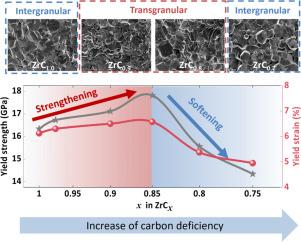Strengthening or softening: On the impact of off-stoichiometry on the mechanical properties of ZrC
IF 8.3
1区 材料科学
Q1 MATERIALS SCIENCE, MULTIDISCIPLINARY
引用次数: 0
Abstract
Transition metal carbides (TMCs) hold great potential for a wide range of applications due to their superior hardness and high melting temperatures. In TMCs, carbon deficiency often leads to off-stoichiometry, which profoundly influences their mechanical properties, though reports on this effect are inconsistent. A mechanistic understanding of this phenomenon is hindered by the lack of suitable interatomic potentials to accurately model the complex covalent and ionic interactions within TMCs. This study explores the role of off-stoichiometry on the mechanical properties and grain boundary (GB) strength of ZrC, a representative TMC. Molecular dynamics (MD) simulations are performed by developing a machine-learned interatomic potential, and the findings are further validated by experiments. Our results reveal that off-stoichiometry detrimentally affects Young's modulus, shear modulus, and yield strength of the grain interior of ZrC. In contrast, the fracture behavior at GBs is primarily governed by local atomic strain redistribution, particularly around stiff C–C bonds. As a result, significant stress concentration on adjacent Zr–C bonds occurs, causing early bond breakage and the initiation of failure. Notably, both simulation and experimental results demonstrate that a slight reduction in carbon content enhances GB strength by alleviating stress concentration. By adjusting the carbon deficiency in the GB region, we can effectively reduce stress concentration and improve GB strength. These findings elucidate the contrasting effects of off-stoichiometry on bulk and GB properties and clarify the debated role of off-stoichiometry, emphasizing the necessity for a deeper understanding of the composition-property relationships in TMCs.


求助全文
约1分钟内获得全文
求助全文
来源期刊

Acta Materialia
工程技术-材料科学:综合
CiteScore
16.10
自引率
8.50%
发文量
801
审稿时长
53 days
期刊介绍:
Acta Materialia serves as a platform for publishing full-length, original papers and commissioned overviews that contribute to a profound understanding of the correlation between the processing, structure, and properties of inorganic materials. The journal seeks papers with high impact potential or those that significantly propel the field forward. The scope includes the atomic and molecular arrangements, chemical and electronic structures, and microstructure of materials, focusing on their mechanical or functional behavior across all length scales, including nanostructures.
 求助内容:
求助内容: 应助结果提醒方式:
应助结果提醒方式:


